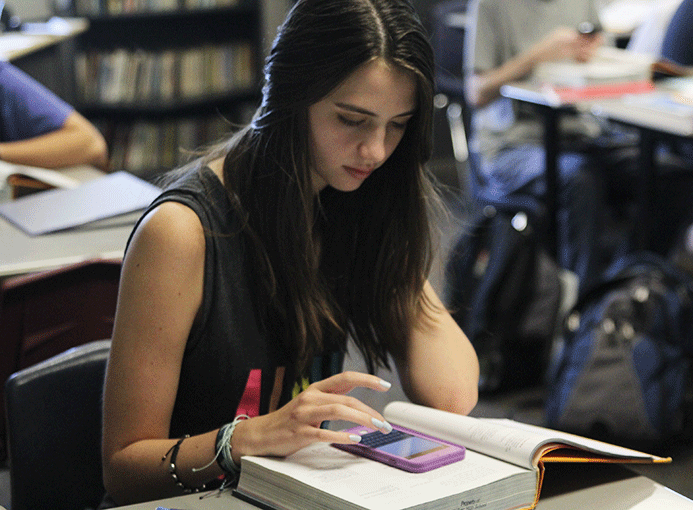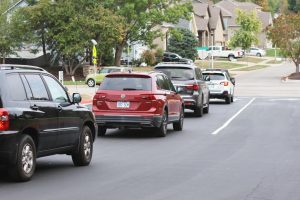School cuts paper usage
School attempts to use more technology to cut down on the use of paper
In communication arts teacher Mike Strack’s classroom on Thursday, Sept. 3, senior Lily Sawyer uses her phone to get on Blackboard. After reading a story, she used the discussion board feature to answer a writing prompt.
September 22, 2015
Paper is a consistent part of the daily lives of teachers and students, from homework to tests. However, several teachers have been trying to cut paper usage in the classroom by using more technology in order to save time, money and trees.
Communication arts teacher Michael Strack has begun to use more technology, and as a result, has saved a considerable amount of paper due to the integration of online resources along with lesson plans.
“[My paper usage is] probably at least 50 percent less,” Strack said. “Previously, I would have [the students] respond either on their own paper or the sheet that I handed them, so one way or another we have reduced it significantly so far.”
Strack isn’t the only teacher cutting back; social studies teacher Jack Johnson has been using technology rather than paper, and agrees that most teachers should try to do the same.
“It saves copy time, and lesson planning is more efficient,” Johnson said. “It helps people embrace what’s going on [in the world]. Students are more engaged this way, and it’s about the students, not the teachers.”
Communication arts teacher Peter Shull prefers using paper in the classroom because he believes it enhances the learning process for students.
“I think that there’s a tactile connection in learning, especially in reading and writing, and I think that when students have the ability to write on something that they’re working with they can interact with it more fully,” Shull said. “ … I think, as technology stands right now, it’s easier for students to work with a hard copy of a novel than it is an electronic copy.”
Sophomore Cody Robertson agrees that technology is not always the best option.
“It takes up a bit more space. It’s like another textbook you might have to carry around,” Robertson said. “You could have connection issues and not be able to access your assignments. Charging is a big issue, because if everybody has [technology], there aren’t going to be many spaces to charge.”
Senior Lindsay Vanlerberg has adopted the habit of bringing her personal laptop as opposed to using the school technology in regards to the Bring Your Own Device (BYOD) policy.
“It is easier to have [your computer] in front of you individually instead of having to look up at the board for everything,” Vanlerberg said. “If you have [your work] pulled up and you have a question about it, you can easily just switch over tabs and Google it, or pull up another resource on your laptop. I like that a lot.”
Although there are many benefits to technology’s replacement of paper, some teachers have realized there may be some drawbacks.
“I prefer computers, but when they break down, I need a Plan B, maybe even a Plan C. We can’t have 25 kids doing nothing,” math teacher Laurie Deuschle said. “We need better reliability, so there can be access all the time. There needs to be enough for everyone.”
Shull believes that although there are advantages to technology, paper is more useful in a school environment.
“I’ve worked in schools that had iPad initiatives, and the ability to distribute texts quickly electronically and the advantage of students not losing those things in backpacks or on the floors of their cars is pretty huge,” Shull said. “But I like the ability of students to write on handouts, and I value that more.”
For Strack, the new technology has not drastically affected his daily teaching routine. Students are still learning the same material, just in a new form.
“I don’t think [technology] has really changed much about how I teach,” Strack said. “It’s simply a new medium … [Students are] really just answering on some technology program as opposed to on paper or with their mouths.”
Johnson has experienced the change over time in the school’s use of technology, and concludes it will help students reach their full potential.
“There’s Internet now. We also have school Wi-Fi, so students don’t have to use their data,” Johnson said. “[Technology] helps with efficiency and embracing the twenty-first century.”












